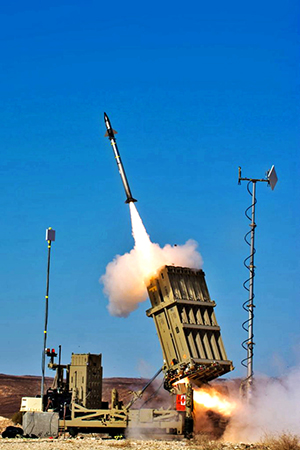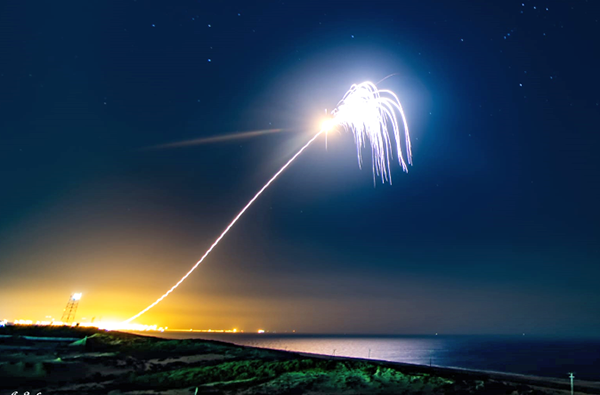On October 7, Hamas militants launched a barrage of rockets from the blockaded Gaza Strip towards Israel as part of a surprise attack that has reignited the Israeli-Palestinian conflict.
Key to repelling rockets on the Israeli side is the Iron Dome, a missile defence system that has become a cornerstone of the country’s security since its initial deployment in 2011.
In the months since the Hamas attack and Israel’s retaliatory military ground offensive, the Iron Dome has once again been tested with an attack by Iran on Saturday and Sunday (April 13 and 14).
Around 300 drones, ballistic and cruise missiles were launched by Tehran following a suspected Israeli strike on a Iranian consulate in Syria. Most of these were intercepted by the Iron Dome.
The system is the pivotal lower tier of a triad of systems in Israel’s air defense system.
The “David’s Sling” system covers the middle layer, while the “Arrow” missile system protects Israel from long-range projectiles.
How does the Iron Dome work?
The Iron Dome is a mobile defense system developed by Rafael Advanced Defense Systems and Israel Aerospace Industries developed, produced and fielded in 2011 to respond to the security threat posed by the bombings of rockets and projectiles shot into Israel, many of which landed in heavily populated areas.


The Iron Dome functions by detecting, analyzing and intercepting varieties of targets such as mortars, rockets, and artillery. It has all-weather capabilities and is able to function night or day and in all conditions, including fog, rain, dust storms and low clouds. It is able to launch a variety of interceptor missiles.
Israel is protected by 10 Iron Dome batteries, functioning to protect the country’s infrastructure and citizens. Each battery is able to defend up to 60 square miles. They are strategically placed around Israel’s cities in order to intercept projectiles headed towards these populated areas. Implementing artificial intelligence technology, the “Dome” system is able to discriminate whether the incoming threats will land in a populated or in an uninhabited area, ignoring them in the latter case, consequently reducing the cost of operation and keeping unnecessary defensive launches to a minimum. However, if the Dome determines that the rocket is projected to land in an inhabited area, the interceptor is fired towards the rocket.
The Iron Dome functions by detecting, analyzing and intercepting varieties of targets such as mortars, rockets, and artillery. It has allweather capabilities and is able to function night or day and in all conditions, including fog, rain, dust storms and low clouds. It is able to launch a variety of interceptor missiles.
A radar steers the missile until the target is acquired with an infrared sensor. The interceptor must be quickly maneuverable because it must intercept rudimentary rockets that are little more than a pipe with fins welded onto it, which makes them liable to follow unpredictable courses. It can be assumed that the launchers of the rockets know as little as the Israelis as to where the rockets would end up landing.
Israeli authorities have claimed that the military technology boasts a 90 per cent success rate at intercepting enemy rockets.
Each Iron Dome battery has three components. The first is a radar that detects incoming rockets. Then there is the Tamir interceptor missile that is launched to intercept the incoming rocket in the air.
Finally, there is a command and control centre which contains the software that creates and sends the message from the radar to the interceptor missile.
The system is designed to intercept rockets with a range of between 4 km and 70 km.
How effective is the Iron Dome?
Iron Dome has proved to be particularly effective over the years.
Bombings into Israel intensified during the 2006 Second Lebanon War when Hezbollah? fired approximately 4,000 rockets from bases in the south of Lebanon. From Gaza to the South, an estimated 8,000 projectiles were launched between 2000 and 2008, mostly by Hamas??. To counter these threats, the Defense Ministry, in February 2007, decided on the development of the Dome to function as a mobile air defense system for Israel. After its period of development and testing, the system was declared operational and fielded in March 2011.
The Israeli government has said is that the effectiveness of Iron Dome is very high. The Iron Dome only intercepts or destroys rockets which are considered to threaten civilian urban areas. If a rocket is sent from Gaza to an unpopulated area in Israel, Iron Dome will not be activated.
READ MORE: Gaza Conflict and the Role of Iron Dome
Biut the Iron Dome system has not deterred Hamas or other Palestinian militant groups from launching rocket attacks targeting Israeli territory. The Iron Dome may be effective operationally, but strategically it does not really deter the Palestinian organisations.
The IDF (Israel Defense Force) claims an 85% – 90% success rate for the “Iron Dome” in intercepting incoming projectiles. Operational in March 2011, to date the Iron Dome has successfully destroyed approximately 1,500 rockets. The destruction of these incoming rockets has saved Israeli lives offering physical protection and shielding property and other assets. In addition, for the Israelis it serves as a psychological safeguard and comfort for the Israeli people.
Regarding the Dome as an asset for Israel’s National Security Strategy, while standing as an undeniable asset, has had mixed results regarding its four major pillars of Deterrence, Early, Active Defense and Decisive Victory as well as some unintended challenges.
How is the Iron Dome financed?
Keeping the Iron Dome operational comes at a high price. Just one of the interceptor Tamir missiles is estimated to cost around $50,000.
Originally Iron Dome funding was undertaken by Israel, but because of the high cost of the system, the country has had to rely on its long-time ally, the United States.
A report from the US Congressional Research Service states that the US has contributed nearly $3 billion to Iron Dome batteries, interceptors, co-production costs, and general maintenance.
Fears of Escalation
In the early days of the current conflict, the sheer number of rockets that Hamas fired towards Israel, estimated to be between 2,200 and upwards of 3,000 (though Hamas claims to have fired 5,000), seemed to succeed in overwhelming the system. Perhaps the biggest concern with respect to Iron Dome’s capability to continue protecting Israeli territory, is the prospect of a regional escalation in the current conflict.
Hezbollah has a much bigger firepower capability than than Hamas. It has hundreds of thousands of rockets. So Hezbollah could very quickly overwhelm Iron Dome.
Future Use
In addition, while the “Dome” suffices for now, it cannot be expected to continue this way forever. Despite the system’s effectiveness, it is just a matter of time before the militants develop tactics or acquire the technology to overcome it.
As technologies develop and are implemented in operations, counter techniques can shift and new tactics can be developed, which is what the militias are only bound to do. Moreover, with the heavy funding available to the militias from their wealthy allies, acquiring more advanced technologies becomes more probable. This is a significant disadvantage for Israel. In order to preserve their upper hand, constant innovation and adaptation is a necessity. Despite these drawbacks, however, in all the positive aspects that the system offers clearly outweighs the negative. The Iron Dome stands undeniably as a critical and outstanding military asset to Israel’s National Security, even while Israel works to address and mitigate some of the unforeseen challenges related to the system.

















